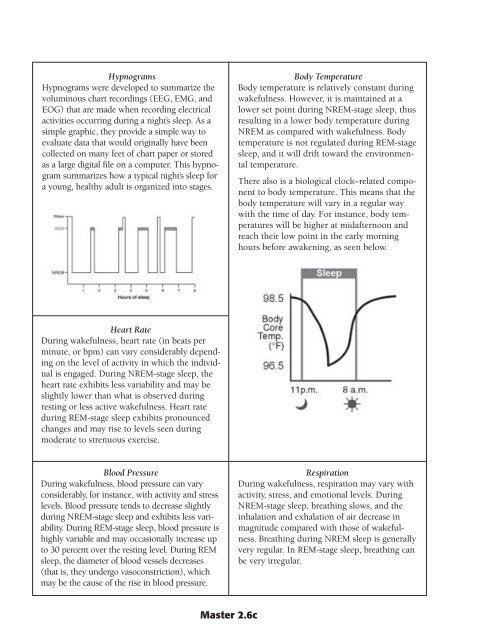Biological - NIH Office of Science Education - National Institutes of ...
Biological - NIH Office of Science Education - National Institutes of ...
Biological - NIH Office of Science Education - National Institutes of ...
Create successful ePaper yourself
Turn your PDF publications into a flip-book with our unique Google optimized e-Paper software.
Hypnograms<br />
Hypnograms were developed to summarize the<br />
voluminous chart recordings (EEG, EMG, and<br />
EOG) that are made when recording electrical<br />
activities occurring during a night’s sleep. As a<br />
simple graphic, they provide a simple way to<br />
evaluate data that would originally have been<br />
collected on many feet <strong>of</strong> chart paper or stored<br />
as a large digital file on a computer. This hypnogram<br />
summarizes how a typical night’s sleep for<br />
a young, healthy adult is organized into stages.<br />
Body Temperature<br />
Body temperature is relatively constant during<br />
wakefulness. However, it is maintained at a<br />
lower set point during NREM-stage sleep, thus<br />
resulting in a lower body temperature during<br />
NREM as compared with wakefulness. Body<br />
temperature is not regulated during REM-stage<br />
sleep, and it will drift toward the environmental<br />
temperature.<br />
There also is a biological clock–related component<br />
to body temperature. This means that the<br />
body temperature will vary in a regular way<br />
with the time <strong>of</strong> day. For instance, body temperatures<br />
will be higher at midafternoon and<br />
reach their low point in the early morning<br />
hours before awakening, as seen below.<br />
Heart Rate<br />
During wakefulness, heart rate (in beats per<br />
minute, or bpm) can vary considerably depending<br />
on the level <strong>of</strong> activity in which the individual<br />
is engaged. During NREM-stage sleep, the<br />
heart rate exhibits less variability and may be<br />
slightly lower than what is observed during<br />
resting or less active wakefulness. Heart rate<br />
during REM-stage sleep exhibits pronounced<br />
changes and may rise to levels seen during<br />
moderate to strenuous exercise.<br />
Blood Pressure<br />
During wakefulness, blood pressure can vary<br />
considerably, for instance, with activity and stress<br />
levels. Blood pressure tends to decrease slightly<br />
during NREM-stage sleep and exhibits less variability.<br />
During REM-stage sleep, blood pressure is<br />
highly variable and may occasionally increase up<br />
to 30 percent over the resting level. During REM<br />
sleep, the diameter <strong>of</strong> blood vessels decreases<br />
(that is, they undergo vasoconstriction), which<br />
may be the cause <strong>of</strong> the rise in blood pressure.<br />
Respiration<br />
During wakefulness, respiration may vary with<br />
activity, stress, and emotional levels. During<br />
NREM-stage sleep, breathing slows, and the<br />
inhalation and exhalation <strong>of</strong> air decrease in<br />
magnitude compared with those <strong>of</strong> wakefulness.<br />
Breathing during NREM sleep is generally<br />
very regular. In REM-stage sleep, breathing can<br />
be very irregular.<br />
Master 2.6c

















